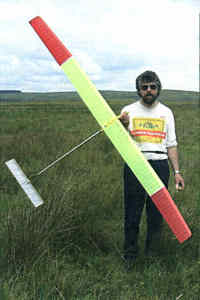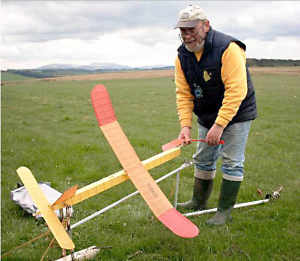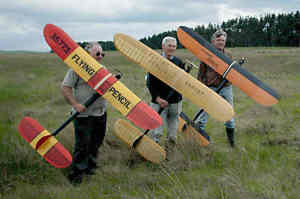Model planes which fly entirely on their own with no form of external control were the first type of model aircraft. They are designed to stabilise themselves when disturbed in the air by gusts and turbulence. There are three main types of free flight models.
The Towline Glider.

The flyer kites his/her model to the top of a line, typically 50 metres long and searches for lift by feeling the tension in this line, then releases the model to fly free. The flight time starts from the point of release from the line. Athletic and skilled fliers can tow models for many minutes in search of a thermal in good conditions. Windy conditions can cause a 50 yard sprint toward the model to reduce the strain on the model while getting it the top of the line.
The Rubber Model.

A hank of strong rubber is tight wound into the fuselage of the model and drives a large hand carved propeller, typically 24″ diameter and 30″ pitch. In an Open Rubber model where there are no restrictions, the rubber can make up 50% of the flying weight. The flight is timed from launch. The power run is generally over a minute, after which the large propeller blades are arranged to fold flat along the side the fuselage for the gliding portion of the flight.
The Power Model.

Here a glow, diesel, or electric motor gives a rapid climb with a very short motor run – 7, 10, 12 or 15secs depending on the contest type. Clockwork or Electronic timers are used to stop the motor. The model is gliding for the remainder of the flight. A good power model will perform a steep spiral climb to over 400 ft in 10 secs. When the motor stops the model needs to transfer smoothly into a slow circling glide. It is a challenging design and trimming prospect when you have no control of the model after launch.
F/F duration models are designed purely for performance and there no attempt to even resemble full size aircraft
